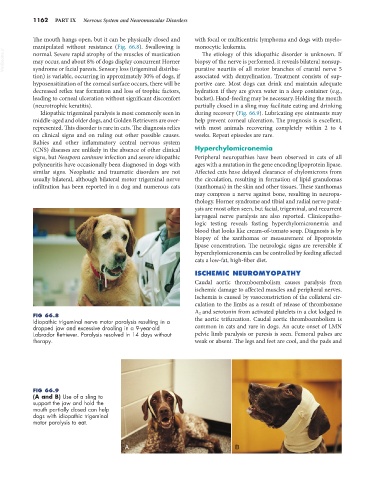Page 1190 - Small Animal Internal Medicine, 6th Edition
P. 1190
1162 PART IX Nervous System and Neuromuscular Disorders
The mouth hangs open, but it can be physically closed and with focal or multicentric lymphoma and dogs with myelo-
manipulated without resistance (Fig. 66.8). Swallowing is monocytic leukemia.
VetBooks.ir normal. Severe rapid atrophy of the muscles of mastication biopsy of the nerve is performed, it reveals bilateral nonsup-
The etiology of this idiopathic disorder is unknown. If
may occur, and about 8% of dogs display concurrent Horner
syndrome or facial paresis. Sensory loss (trigeminal distribu-
associated with demyelination. Treatment consists of sup-
tion) is variable, occurring in approximately 30% of dogs, if purative neuritis of all motor branches of cranial nerve 5
hyposensitization of the corneal surface occurs, there will be portive care. Most dogs can drink and maintain adequate
decreased reflex tear formation and loss of trophic factors, hydration if they are given water in a deep container (e.g.,
leading to corneal ulceration without significant discomfort bucket). Hand-feeding may be necessary. Holding the mouth
(neurotrophic keratitis). partially closed in a sling may facilitate eating and drinking
Idiopathic trigeminal paralysis is most commonly seen in during recovery (Fig. 66.9). Lubricating eye ointments may
middle-aged and older dogs, and Golden Retrievers are over- help prevent corneal ulceration. The prognosis is excellent,
represented. This disorder is rare in cats. The diagnosis relies with most animals recovering completely within 2 to 4
on clinical signs and on ruling out other possible causes. weeks. Repeat episodes are rare.
Rabies and other inflammatory central nervous system
(CNS) diseases are unlikely in the absence of other clinical Hyperchylomicronemia
signs, but Neospora caninum infection and severe idiopathic Peripheral neuropathies have been observed in cats of all
polyneuritis have occasionally been diagnosed in dogs with ages with a mutation in the gene encoding lipoprotein lipase.
similar signs. Neoplastic and traumatic disorders are not Affected cats have delayed clearance of chylomicrons from
usually bilateral, although bilateral motor trigeminal nerve the circulation, resulting in formation of lipid granulomas
infiltration has been reported in a dog and numerous cats (xanthomas) in the skin and other tissues. These xanthomas
may compress a nerve against bone, resulting in neuropa-
thology. Horner syndrome and tibial and radial nerve paral-
ysis are most often seen, but facial, trigeminal, and recurrent
laryngeal nerve paralysis are also reported. Clinicopatho-
logic testing reveals fasting hyperchylomicronemia and
blood that looks like cream-of-tomato soup. Diagnosis is by
biopsy of the xanthomas or measurement of lipoprotein
lipase concentration. The neurologic signs are reversible if
hyperchylomicronemia can be controlled by feeding affected
cats a low-fat, high-fiber diet.
ISCHEMIC NEUROMYOPATHY
Caudal aortic thromboembolism causes paralysis from
ischemic damage to affected muscles and peripheral nerves.
Ischemia is caused by vasoconstriction of the collateral cir-
culation to the limbs as a result of release of thromboxane
A 2 and serotonin from activated platelets in a clot lodged in
FIG 66.8
Idiopathic trigeminal nerve motor paralysis resulting in a the aortic trifurcation. Caudal aortic thromboembolism is
dropped jaw and excessive drooling in a 9-year-old common in cats and rare in dogs. An acute onset of LMN
Labrador Retriever. Paralysis resolved in 14 days without pelvic limb paralysis or paresis is seen. Femoral pulses are
therapy. weak or absent. The legs and feet are cool, and the pads and
FIG 66.9
(A and B) Use of a sling to
support the jaw and hold the
mouth partially closed can help
dogs with idiopathic trigeminal
motor paralysis to eat.
A B

